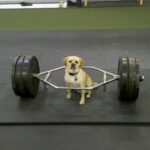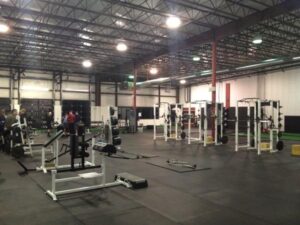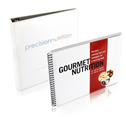Written on October 25, 2012 at 4:39 pm, by Eric Cressey
I'm going to let you in on a little shocker: I really don't train as hard as I used to train.
Blasphemy, I know.? Every strength and conditioning coach is supposed to constantly be pursuing a mythical level of fitness at all times.? Because it's my job to make people healthier and more athletic, I, in turn, am expected to be able to bench press 800, vertical jump 40 inches, complete a marathon in under three hours, and be able to fart lightning at a moment's notice.? While I can make a decent run at the last challenge after a batch of my mom's famous calico beans recipe, I guess I'm just content with not making optimal progress.
Now, don't get me wrong; I haven't let myself turn into a blob, and I'm still training 5-6 days a week.? The goals, however, have shifted since my last powerlifting meet in December of 2007. Nowadays, I get a lot more excited about watching one of our minor league guys get a big league call-up than I do about a ten-pound squat personal record after a 16-week training cycle. I worry more about being a better husband, business partner, boss, and coach than I do about whether I'm 10 or 11% body fat, and whether it'll make my weight class. And, I certainly expect these priorities to change even more when my wife and I decide to have kids.
In short, I think I'm a lot like a solid chunk of the exercising population.? Training hard excites me, but it doesn't define me anymore.
Interestingly, though, I really haven't wasted away like one might expect. In fact, I've gotten stronger while keeping my weight about the same - or slightly lower, right where I want to be.? Just for the heck of it, I staged my own little mock raw powerlifting meet this morning and totaled 1435 at a body weight of 180.6 (1396 is considered an "Elite" total, as a frame of reference).? I used the giant cambered bar for squatting, simply because my shoulder gets cranky when I back squat. Sue me.
A few notes on the mock/impromptu meet:
1. Thanks to the CP staff and interns for helping with spots, handoffs, and videos - and putting up with my musical selection (which I think, for the record, was an outstanding representative sample of modern training music).
2. I weighed in at 180.6 first thing that morning (about three hours before I lifted).? I didn't have to cut weight.
3. I had a scoop of Athletic Greens, three cups of coffee with vanilla protein powder, and five eggs with spinach, peppers, and onions for breakfast, then drank a bottle of water at the facility before I started.? So, I really didn't carb up for this "meet" (or really prepare for it in any capacity, for that matter). I did have an accidental open mouth kiss with my dog, Tank, while I was foam rolling when he licked my face while I wasn't looking.? I'm not sure if making out with a puggle constitutes ergogenic assistance??

4. Speaking of Tank, he makes a great cameo during my opening squat.? He's eating air, in case you're wondering.
5. The great thing about squats in powerlifting meets is that they can look like good mornings to parallel and still pass.? Score!
6. I haven't free squatting with a wider, powerlifting style stance in about three years. So, you can say that I was a bit rusty, as evidenced that my stance width was a bit erratic from attempt to attempt (and especially narrow on the third squat).
7. The first squat and last deadlift were exactly 90 minutes apart.? Talk about efficiency!
All that said, I really don't think I could have even come close to this total back in 2007, and according to some research that says strength peaks at age 29, I should be on the downslope, especially if I'm not training as hard. So, what gives?
I suspect it has a little something to do with the fact that I have a pretty good idea of how to sustain a strength training effect. Much of it has to do with my experiences with in-season athletes; some of them waste away if they don't pay attention to detail and stay consistent with their training.? Meanwhile, others come back so strong that you'd think they never left.? Here are some of the factors that have surely helped me (and them) over the years.
1. Very little alcohol consumption.
My first date with my wife was April 22, 2007. She's seen me drink twice in the entire time we've known one another. I'm absolutely not going to stand on a soapbox and say that I don't think other people should drink; they can do what they want, but it just really isn't for me.
That said, if you're concerned with helping your strength training gains along (or simply sustaining them), simply have a look at the research on alcohol's negative effect on effect on endocrine status, sleep quality, neural drive, tissue quality, and recovery from exercise.? People who drink a lot feel and move like crap.? Sorry, I don't make the rules.
2. Early to bed, early to rise.
I find the 6AM world far more entertaining, refreshing, and productive than the 1AM world.? I feel better, train better, recovery better, and am an all-around happier person when I get to bed early and awake early without an alarm.? For me, 10:30PM to 6AM is pretty much the norm.
Now, for those who insist that sleeping 1:30AM to 9AM counts exactly the same, check out some of the research on night shift workers and their health; it's not good.? As a rule of thumb, one hour before midnight is worth two after midnight - and it certainly helps to try to go to bed and wake up at the same times each day.? Post-Thanksgiving meal naps are spectacular, too.

3. A foundation of strength and mobility.
In talking with our athletes about the relationship between off- and in-season training, I use the analogy of a bank account.? During the off-season, you make deposits (work hard and acquire a training effect).? When you go in-season, you make withdrawals (play your sport). If the withdrawals exceed the deposits, you're in trouble - and that's why in-season training is so important.
Now, for the general fitness folks, this simply means that if you put a lot of "money in the bank," you'll be prepared for the day when life gets crazy and you miss a few days in the gym.? You have more wiggle room to go on a spending spree.
Mobility works the same way.? Once you've built it, it's hard to lose unless you really go out of your way to avoid moving for an extended period of time.
4. Regular manual therapy.
I'm very fortunate to have two outstanding manual therapists in my office on a weekly basis.? Chris Howard is a massage therapist and does a tremendous job with more diffuse approaches, recovery modalities, and some focal work with the Fibroblaster tool.? Nate Tiplady utilizes Graston Technique, Active Release, fascial manipulation, and chiropractic adjustments.? Along with regular foam rolling, these guys have made a big difference in me staying healthy, which leads me to...
5. No missed training sessions.
I'm fortunate to have been very healthy over the years.? Like everyone, I've had minor niggles here and there, but haven't pushed through them and let them get out of hand.? It's better to skip benching one day and do higher rep floor presses than it is to push through some pain and wind up with a torn pec.? If long-term consistency is your goal, you have to be willing to assess risk: reward in your training on a regular basis.
Moreover, training is a part of my life, just like brushing my teeth, feeding the dog, or checking my email.? It's not an option to "squeeze it out" because the schedule gets too full.? I make time instead of finding time.? Of course, it's a lot easier when your office is part of a 15,000+ square-foot gym!

6. Lots of vegetables and quality protein.
Call me crazy, but I'd take grass-fed meatloaf and spinach and onions cooked in coconut oil over a chocolate cake any day of the week.? I'm not making that up; I just don't have much of a sweet tooth.
In Precision Nutrition, Dr. John Berardi talks about the 90% rule: as long as you're good with your nutrition 90% of the time, you can get away with slip-ups or intentional cheat meals for the other 10%.? If you eat five meals a day, that's 31-32 "clean" meals and 3-4 "whoops" meals each week.? When I think about it in that context, I'm probably more like 95-98% adherent, and the other 2-5% is me grabbing a protein bar on the fly while I'm coaching at CP. I could certainly do a lot worse.

I'm sure Dr. Berardi would agree that if you get closer to 100%, you likely have a little wiggle room with your training program. For example, you might be able to cut back slightly on the amount of conditioning needed to meet your goals.
7. Great training partners.
I've been extremely fortunate to lift in a number of great environments, from my time in the University of Connecticut varsity weight room, to my days at Southside Gym, to Cressey Performance 1.0, 2.0, and now 3.0.? You've always got spotters nearby, and there are always guys to give you feedback on weight selection and technique.? We crack jokes, play loud music, and challenge and encourage each other.? I'm convinced that this factor more than any other can absolutely revolutionize the way many folks train; they need human interaction to get out of their comfort zone and realize what they're capable of accomplishing in the right environment.
8. Planned deloads.
I rarely take a week of training off altogether, but at least once a month, I'll reduce training stress substantially for 5-7 days to recharge.? The secret to avoiding burnout is to understand the difference between overload, overreaching, and overtraining.? The former two are important parts of the training equation, but if you are always seeking them 24/7/365, you can wind up with the latter. I talk about this in great detail in my e-book, The Art of the Deload.

9. Accountability.
In my opinion, one of the main reasons many people struggle to achieve their fitness goals is that they are only accountable to themselves - and that's a slippery slope if you aren't blessed with great willpower and perseverance.? It's one reason why we encourage our clients to tell their friends and family about their fitness goals; they'll constantly be reminded of them in conversation throughout the day.
Being in the fitness industry is a blessing because your peers and your clients/athletes are your accountability.? Fat personal trainers don't have full schedules.? Weak people don't become strength coaches of NFL teams.? And, in my shoes, it's magnified even more because I'm in front of thousands of people every single day through the videos on this website, DVDs that we've produced, and seminars at which I present.? Even if "tapping out" on my training was something that interested me, I have too much at stake.? Think about where you can find that level of accountability in your life to help you reach your goals.
10. Cool implements to keep things fun.
I live really close to our facility, so I often joke that I have the best 15,000 square-foot home gym you'll ever see.? We've got a bunch of specialty bars, bumper plates, slideboards, sleds, tires, sledgehammers, turf, kettlebells, dumbbells, bands, chains, farmer's walk handles, TRX units, medicine balls, a glute-ham, chest-supported row, functional trainers, benches, and a host of other implements that I'm surely forgetting.? There is absolutely no excuse for me to ever get bored with training, as I have an endless source of variety at my fingertips.
Now, I know some of you are thinking, "But Eric, I don't have anything cool at my commercial gym!"? My response to that has five parts:
a. If they didn't have what you needed, why did you give them your money instead of taking your business elsewhere?
b. Have you considered outfitting home gym?
c. They probably have a lot more than you might think, but you just need to be more creative and prepare a bit more.
d. Remember that there are many different ways to add variety to programming beyond just changing exercise selection.? You can tinker with sets, reps, rest intervals, training frequency, tempo, range-of-motion, and a host of other factors.
e. Have you used a strength and conditioning program written by a qualified coach? He or she may see the same equipment through a different lens than you do.?
These are surely just ten of countless factors that one can cite when it comes to sustaining performance over the long haul, and I'm sure that they'll change as I get older.? With that said, I'd love to hear your thoughts in the comments section: what factors have contributed to you making (or sustaining) progress with your strength and conditioning programs?
Looking for a program to take the guesswork out of your programming?? Check out Show and Go: High Performance Training to Look, Feel, and Move Better.

Sign-up Today for our FREE Newsletter and receive a four-part video series on how to deadlift!
16 Comments
Category Blog | Tags: Are of the Deload,Athletic Greens,Bench Press,Deadlift,deadlift technique,Deadlifts,High Performance Training,How to Deadlift,John Berardi,Move Better,Precision Nutrition,Show and Go,Strength and Conditioning,strength and conditioning program,strength and conditioning programs,Strength Training,strength training program,strength training programs
Leave a Reply
Source: http://www.ericcressey.com/10-ways-training-effect-strength-and-conditioning-programs
vampire diaries miley cyrus miley cyrus derek jeter Red Bull Stratos Redbull Stratos justin tv
No comments:
Post a Comment
Note: Only a member of this blog may post a comment.